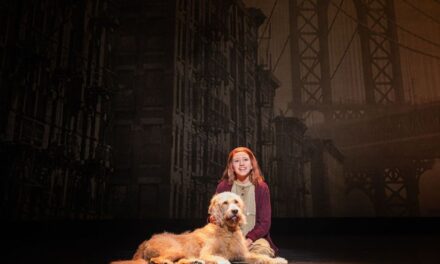SALT LAKE CITY — In the director’s note in the GO TO HELL program, writer-director Jeremey Catterton says, “I remember the day I got the call from [producer] Dave Fetzer. He said, it’d be Christmas time, but… [this] was to be more of an alternative to everything else being produced in SLC at the same time. I said I needed to think, and, within 24 hours, I e-mailed back: Dear David, it will be called GO TO HELL.” The play is certainly different from anything else you’re likely to see onstage–an examination of a hellish marriage that is equal parts theater, multimedia, and haunted house.
GO TO HELL takes some of the myth of Orpheus and Eurydice and places it in the present, with a young contemporary couple (Orpheus is a celebrated writer of some kind) who find themselves caught in a hellish marriage. Still, it could be argued that the Orpheus-Eurydice relationship is really just the McGuffin of this play–the excuse for the real meat of the piece, the descent into hell. And, in creating a one-hour hell-on-earth, GO TO HELL is very successful.
Unfortunately, the relationship between Orpheus and Eurydice is perhaps the most unconvincing aspect of the play, both in writing and in execution. The scenes detailing their marital conflict come across as a bit superficial–each of them takes their turn flinging four-letter words at the other, but none of the seem to cut deeply enough. We never get the sense that the couple really knows anything of each other beyond what we learn of them in their meet-cute opening scene together, and because we never see any of their pleasant times together, their pain seems to carry less weight. Perhaps that’s the point, but I found the characters a bit hard to accept as a couple as a result, and it certainly keeps their arguments from having as much dramatic sting as they might–because they don’t seem to know anything about each other, they also don’t seem to know the sorts of comments or criticisms that could be really devastate. I would have liked to see a scene where Eurydice criticizes Orpheus’ writing, for example–a scene that could go beyond mere name-calling and into a place of real vulnerability. Another script-related detail that hurts the dramatic dynamic of the central couple is that they don’t mention they’ve gotten married until quite a bit of time has elapsed. Assuming they were just living together, I wondered why, when she talked about wanting to leave, Eurydice didn’t just leave.
As Orpheus, Tyson Brett tends to over-emote (particularly for such an intimately-sized space); when he scales back, however, Brett’s quiet bitterness has real power. Rhiannon Ross did a fine job as Eurydice, but the lack of chemistry between Ross and Brett after their opening-scene romance made it hard to invest in either of them.
Though it’s a smaller role, Chris Bradshaw does excellent, eerie work as Hades, and his distinctive, deliberate body movement–floating with a mechanical, spider-like rhythm towards the audience–is inexplicably terrifying. Maren Nazera Erickson’s TV-haunting demon is also remarkably creepy–she twists and turns her head and delivers her lines with an eerie grin, her eyes rolling in their sockets and her tongue relishing every syllable. The music, by Sean Jones, and the sound design, by Zach Dupaix, also deserve a good deal of credit in creating the infernal atmosphere. The scenes in hell feel like an assault, and I expect they’re meant to. In his bio, Jones mentions Angelo Badalamenti’s score for Twin Peaks as an inspiration. In some ways, GO TO HELL feels like it’s trying to create the hour-long theatrical equivalent of that TV show’s horrific Red Room—and, more often than not, it works. The projected video—of time-lapse flowers and droplets of water—is appropriately surreal, and adds to the effect.
But my favorite part of the show was John Kuehne’s portrayal of Skull. The skeletal ferryman to hell (though here he rides on a motorcycle rather than a boat), Kuehne bookends and punctuates the piece with some wonderful monologues. These monologues are by far the most well-written scenes the play, and include some descriptions of and riffs on the nature of hell that can be poetic, unnerving, and unspeakably awful, sometimes all at once. Skull—with his Brooklyn accent and lounge-jazz theme music—is also the funniest character in the play, and although the character seems to exist in some kind of drunken limbo between life and death, Kuehne imbues the material with a crackling kind of electric energy. He is a joy to watch.
Though it’s uneven, GO TO HELL is an exciting bit of experimental theater–not everything works, but it’s refreshing to see a group of young actors and theater practitioners doing something different, and the theater at the Utah Pickle Factory is a wonderful match for the offbeat (and, in this case, somewhat seedy) show. This is the first production of the New Works Theatre Machine, and, based on the potential they’ve demonstrated, I’m eager to see what they come up with next.
NOTE: GO TO HELL includes pervasive use of very strong language–including some sexual references–and scenes of violence and disturbing imagery.





